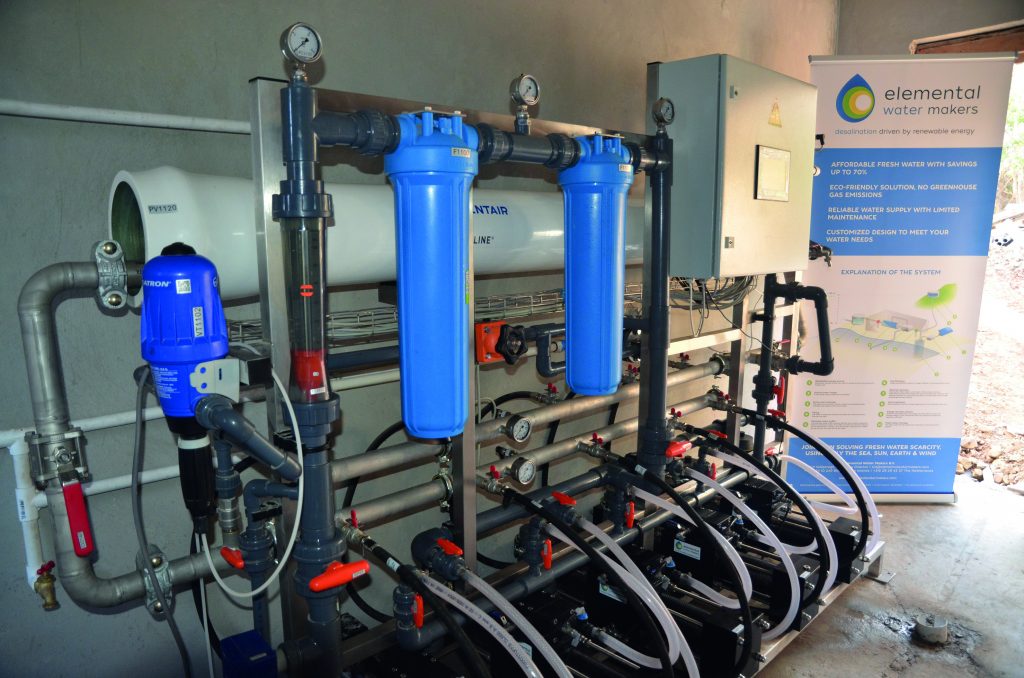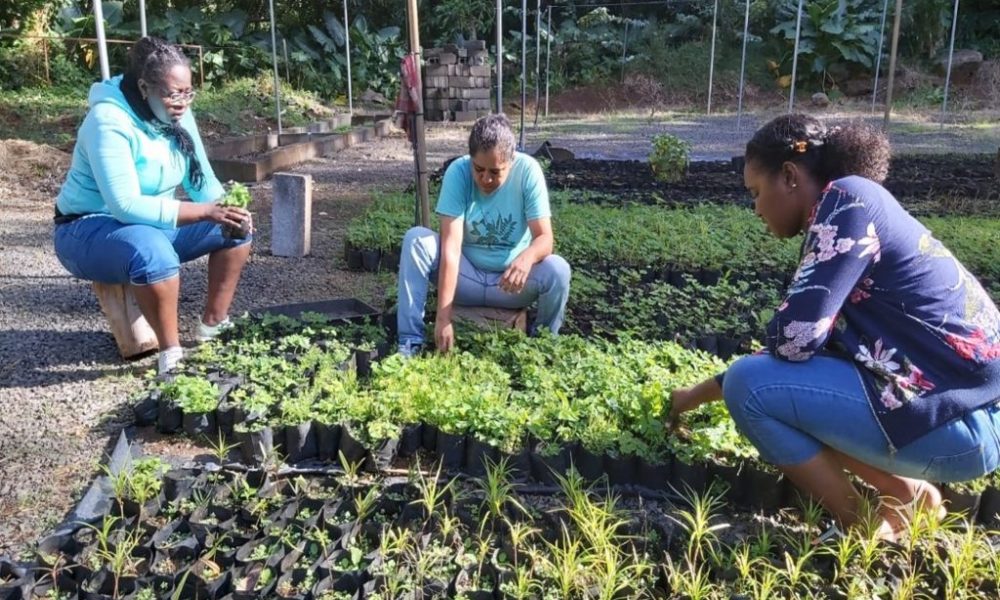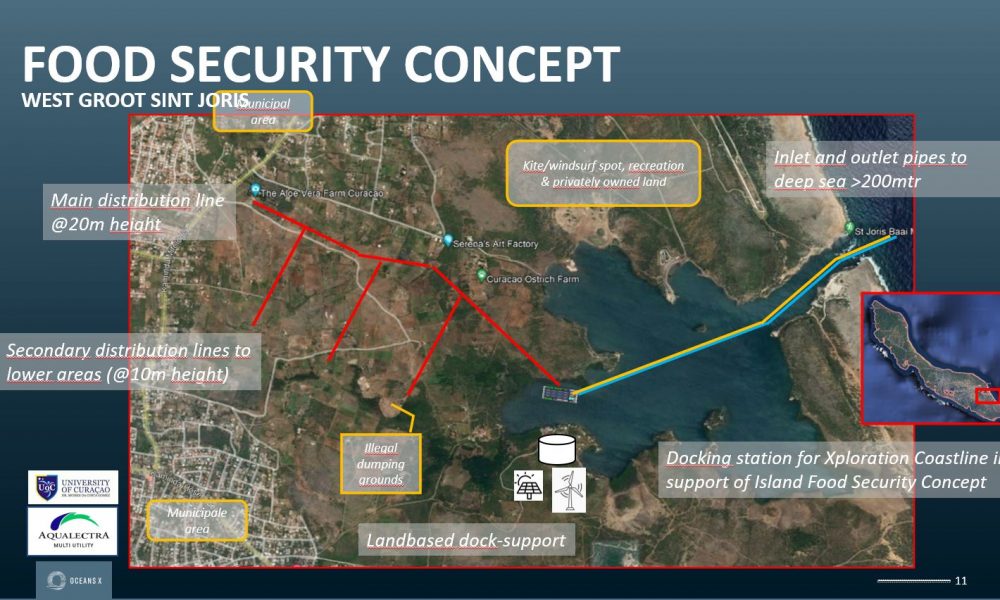Securing fresh water on islands today, without limiting tomorrow
Projects

General information:
Island (Region, Province, Country):
Great Camanoe, British Virgin Islands
Population:
2500
Budget / cost of the project:
150.000 USD
Project objectives:
- Get access to clean water from unlimited resources
- Save 50% on water expenses
- Enable a reliable and independent water supply
Project description of activities and specific interventions:
Already 4 billion people face water scarcity today. Due to growing population, increasing water footprints and climate change, water scarcity is increasing. The majority of islands face a lack of natural freshwater resources. Being at the forefront of climate change, combined with an increase on the demand side through population growth and the rise of tourism, results in potential water scarcity.
Desalination is implemented to solve the water shortages on islands. With the high energy tariffs on our precious islands, desalination of seawater often becomes an expensive exercise. At the same time, islands often enjoy the natural soundtrack of the wind, an abundance of sunshine and 360-degree ocean views. This makes desalination powered directly by renewable energy a topic of increased interest, with a great potential for decentralized and small-scale island applications.
Elemental Water Makers (NL, 2012) secures fresh water today, without limiting tomorrow through desalination powered by renewable energy. This means the opportunity for an affordable & reliable water supply from unlimited resources for resorts, private properties, communities, industries and municipalities on islands and coastal regions. Through any project delivered, a direct impact on the availability of water is achieved, without any greenhouse gas emissions.
The British Virgin Islands are one of the many islands facing water scarcity. In 2015, Elemental Water Makers formulated a project, together with the local end-user, to construct the first off-grid solar-powered desalination unit to get access to clean water. On the island of Great Camanoe a system has been commissioned and personnel was trained to operate and maintain the unit. A video can be enjoyed here: https://www.youtube.com/watch?v=B4irlTMk_Os
The solution generates 12500 liters of clean water from seawater per day, using only the power from the sun. It has survived the impact of the hurricane of Irma in 2017 and has produced over 10 million liters from the sea and sun. The solution saves 63% compared to the previous, fossil powered solution while avoiding 25 tons of CO2 emissions each year. The project has resulted in resilience & independence.
Public outreach, education and awareness efforts and results:
We selected Elemental Water Makers to provide fresh water for our property in the British Virgin Islands because they presented us with a cost-effective solution to creating a continuous supply of very high quality water — without monthly electrical bills and without using fossil fuels.
After struggling for years with high electric costs, power outages and the unreliable water quality and volumes produced by our property’s traditional reverse osmosis system, we now enjoy more than 12500 liters of fresh water every day, using nothing more than sunshine and the natural elevation of our property. And in the process, my children and I are helping to reduce the Virgin Islands’ carbon footprint and preserve its precious environment for future generations. ’
End-user, BVI
The project was embraced by local and global newspapers, for example:
The BVI Beacon
http://bvibeacon.com/tapping-an-unlimited-resource
The Daily Planet:
https://dailyplanet.climate-kic.org/meet-dutch-start-breaking-ground-de-carbonising-desalination
It has been recognized by the Global Island Partnership (GLISPA) as a Brigt Spot The Ruler of Dubai awarded the company with the 1st prize of the Global Water Award in 2017:
https://www.dutchwatersector.com/news-events/news/24841-tno-and-elemental-water-makers-receive-prestigious-mbr-global-water-awards-for-desalination.html
The solution uses an elevated water buffer to cope with the renewable energy fluctuations. In order to provide the system with sufficient pressure during both day and night, the elevation difference must be at least 90m. Fortunately, such elevation differences are widely available in coastal areas. The figure below shows areas which face water stress. Many areas facing stress also have sufficient elevation near the cost. Examples are the Caribbean, the Mediterranean and Pacific Islands, Chile, Peru, West USA, Cape Verde, Morocco, Spain, Algeria, South Africa, Turkey, Yemen, Oman, India, Indonesia and Fiji.
To illustrate its replication potential, 8 projects have been rolled out worldwide since 2015 (Canary Islands, Belize, Cape Verde, Mozambique, Philippines, Indonesia) with similar impact: https://www.youtube.com/watch?v=fjWDcG8xy9s&feature=youtu.be
Economic value added and how calculated:
The entire turn-key solution on the British Virgin Islands including transportation & installation was performed for 150.000 USD. In comparison with a conventional electricity driven reverse osmosis unit, the installed solution has a payback within 5 years, saves 225.000 USD (63%) and has a return-on-investment of 127%. With a production of 12.500 liters per day, the system could provide clean water to 2500 people, assuming 5 liters per person per day.
The comparison has been made with a typical convention turn-key desalination unit of the same size, which has a lower investment of 50.000 USD, but much higher operating expenses due to the electricity use, rated at 18.250 USD per year.
The turn-key installation of the patented technology included:
- Construction of open ocean intake
- Transportation of all components to the outer island
- Gravel filtration bed
- Submersible intake pump of 904L
- Installed PVC Sch. 80 piping towards desalination unit & elevated water buffer
- Desalination unit including energy recovery, multi-media filtration with automated backwash, pre-filtration and automated shut-down valves
- Monitoring interface with 13 sensors connected to the internet & txt warnings
- Elevated water tank
- Concrete slabs for solar panels
- Solar panel array of 12 kWp with frame resistant to 206 km/hr wind loads
- Electric cable from solar panels to the desalination unit
- Brine and product discharge
- Training for operation
The unit has been designed for stress-free operation through automation and remote monitoring.
IRENA has performed a study on Renewable Energy Desalination in 2015. From their analysis, they mentioned cost of water of 5.4 USD/m³ for an off-grid battery PV-RO system of 250 m³/day. The Elemental Water Makers solution of 12.5 m³/day on the British Virgin Islands produces water for 2.5 USD/m³. If a system is designed for 250 m³/day, the water production cost would be between 1-1.5 USD/m³. This shows that the technology is able to produce much lower than the benchmark of 5.4 USD/m³.
Ecological and social project outcomes:
The energy-intensive industry of desalination contributes significantly to the emission of greenhouse gasses. The project shows it’s possible to completely avoid the use of fossil fuels while making sure the desalinated water is affordable and reliable.
As reported by IRENA in 2012 in the Water Desalination Using Renewable Energy Technology Brief, the global production of about 65.2 million m³/d of desalinated water involved the use of at least 75.2 TWh per year, which equalled about 0.4% of the global electricity consumption. With the rising demand for desalination, this number is increasing rapidly.
Finding a way to completely avoid emissions desalination contributes, using only unlimited resources while making sure the water is affordable and reliable, would be a great sustainable achievement.
“If we could ever competitively, at a cheap rate, get fresh water from salt water, that it would be in the long-range interests of humanity which would really dwarf any other scientific accomplishments.” — John F. Kennedy, 1962
Elemental Water Makers have shown that it is possible to do so through this project. 25 tons of CO2 emissions are avoided each year by this installation.
Elemental Water Makers also takes the environmental impact of the brine (or concentrate) flow into consideration. Reverse osmosis can only operate if the retained (salt) particles are discharged from the membranes using the brine flow, often lead directly back to sea. The salinity of this brine flow, which for conventional RO systems is often 60% more saline than the intake, can have a negative effect on the local marine life. In contrary to industry standards, the reverse osmosis solution offered by Elemental Water Makers works on a recovery ratio of only 14%. Due to the highly efficient energy recovery units, this low recovery ratio has no effect on the overall system efficiency, but it does result in a brine flow which is only 17% more saline than the intake. The result is that the brine flow is much easier diluted back to normal seawater conditions and therefore exerts much less stress on the local marine environment than industry-standard reverse osmosis systems.










